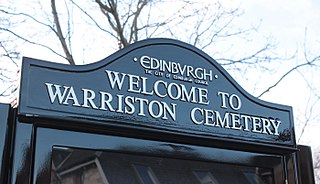Francis Brown Douglas FRSE DL (2 April 1814-8 August 1885) was a Scottish advocate who served as the Lord Provost of Edinburgh from 1859 to 1862.
Contents

Francis Brown Douglas FRSE DL (2 April 1814-8 August 1885) was a Scottish advocate who served as the Lord Provost of Edinburgh from 1859 to 1862.

He was born in Largs in Ayrshire on 2 April 1814, the son of Archibald Douglas (1779-1833), also an advocate, and Jane Brown of Bellair on the island of St. Vincent. He attended the High School of Edinburgh and then Edinburgh Academy (1824-5). He then studied law at the University of Edinburgh.
Following the Slavery Abolition Act 1833, Francis received a considerable sum in compensation for his father's loss (his father being deceased) of 245 slaves on the Sans Souci Estate on St Vincent. This sum, probably received around 1845, totalled £6,418. [1]
In 1839 he was elected a Fellow of the Royal Society of Edinburgh his proposer was John Shank More. [2] In 1843 he left the established Church of Scotland to join the Free Church of Scotland. He was an elder at Pilrig Free Church under the Rev William Garden Blaikie. [3]
On 7 August 1860 he oversaw, as Lord Provost of Edinburgh, the Great Review for Queen Victoria and the Royal Family, which involved over 20,000 persons.
His home for most of his life was 21 Moray Place [4] in the fashionable West End.
He died at Melville House in Fife on 8 August 1885. He is buried in Dean Cemetery in the west of Edinburgh. The grave lies on the western wall at the southern end of Lord's Row. [5]


He was brother to Dr Archibald Douglas and cousin to Dr A. Halliday Douglas. [6]
He was married twice: firstly in 1845 to Mary Turner Christie at Scoonie in Fife; secondly in 1852 to the wealthy Marianne Leslie-Melville (1827-1899), by whom he had nine children. [7]
His eldest son, Francis Archibald Brown Douglas (b.1854) was also an advocate after studying law at the University of Cambridge,
His second son was Charles Christie Brown Douglas (b.1857).

The Dean Cemetery is a historically important Victorian cemetery north of the Dean Village, west of Edinburgh city centre, in Scotland. It lies between Queensferry Road and the Water of Leith, bounded on its east side by Dean Path and on its west by the Dean Gallery. A 20th-century extension lies detached from the main cemetery to the north of Ravelston Terrace. The main cemetery is accessible through the main gate on its east side, through a "grace and favour" access door from the grounds of Dean Gallery and from Ravelston Terrace. The modern extension is only accessible at the junction of Dean Path and Queensferry Road.

Henry Thomas Cockburn of Bonaly, Lord Cockburn was a Scottish lawyer, judge and literary figure. He served as Solicitor General for Scotland between 1830 and 1834.

Sir Henry Raeburn was a Scottish portrait painter. He served as Portrait Painter to King George IV in Scotland.

William Garden Blaikie FRSE was a Scottish minister, writer, biographer, and temperance reformer.
John Colin Dunlop FRSE (1785–1842) was a Scottish advocate and historian.

Patrick Fraser Tytler FRSE FSA (Scot) was a Scottish advocate and historian. He was described as the "Episcopalian historian of a Presbyterian country".

James Syme was a Scottish pioneering surgeon.

Archibald Campbell Colquhoun was a Scottish politician and lawyer from Glasgow. He served as Lord Advocate the highest position in the Scottish legal system.

Stewart's Melville College (SMC) is a private day and boarding school in Edinburgh, Scotland. Classes are all boys in the 1st to 5th years and co-educational in Sixth (final) year. It has a roll of about 750 pupils.

David Welsh FRSE was a Scottish Presbyterian minister and academic. He was Moderator of the General Assembly of the Church of Scotland in 1842. In the Disruption of 1843 he was one of the leading figures in the establishment of the Free Church of Scotland.

Greyfriars Kirkyard is the graveyard surrounding Greyfriars Kirk in Edinburgh, Scotland. It is located at the southern edge of the Old Town, adjacent to George Heriot's School. Burials have been taking place since the late 16th century, and a number of notable Edinburgh residents are interred at Greyfriars. The Kirkyard is operated by the City of Edinburgh Council in liaison with a charitable trust, which is linked to but separate from the church. The Kirkyard and its monuments are protected as a category A listed building.

Warriston Cemetery is a cemetery in Edinburgh. It lies in Warriston, one of the northern suburbs of Edinburgh, Scotland. It was built by the then newly-formed Edinburgh Cemetery Company, and occupies around 14 acres (5.7 ha) of land on a slightly sloping site. It contains many tens of thousands of graves, including notable Victorian and Edwardian figures, the most eminent being the physician Sir James Young Simpson.

Thomas ThomsonFRSE FSA Scot was a Scottish advocate, antiquarian and archivist who served as Principal Clerk of Session (1828–1852) and as secretary of the literary section of the Royal Society of Edinburgh (1812–20).
Professor Archibald Campbell SwintonFRSE DL LLD LLB, was a Scottish author, politician and professor of civil law at Edinburgh, 1842–62.
Events from the year 1817 in Scotland.

Sir Archibald Alison, 1st Baronet, was a Scottish advocate (attorney) and historian. He held several prominent legal appointments. He was the younger son of the Episcopalian cleric and author Archibald Alison. His elder brother was the physician and social reformer William Pulteney Alison.
Sir John Melville FRSE WS was a Scottish lawyer and landowner who served as Lord Provost of Edinburgh from 1854 to 1859. Melville Drive in Edinburgh is named after him.